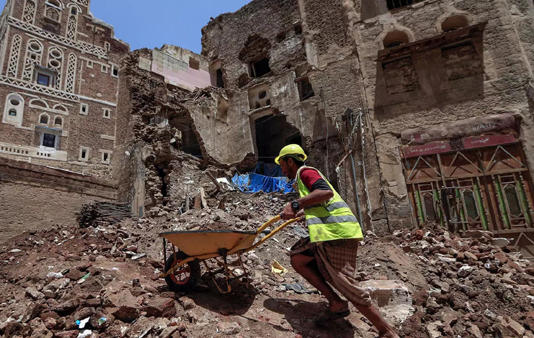SANAA, Aug 13, 2020 (BSS/AFP) – Muddy waters lap overfoot in Sanaa’s Old
City, inhabited without interruption for more than 2,500 years but now facing
disaster after floods that threaten the collapse of irreplaceable houses.
The deluge risks finishing off the destruction of its distinctive buildings
with their ochre brick facades and white latticework windows, experts say.
The foundations were already weakened by bombings in Yemen’s long war.
“Since dawn we have been trying to clean the mud off the roofs and drain
the water — but it’s no use,” said Ali al-Ward, a long-time resident.
“We sleep with fear in the pits of our stomachs. We are between life and
death,” said the frail man with a greying beard as he surveyed the damage in
the UNESCO World Heritage-listed site.
Flooding is common in Yemen at this time of year, blighting the poorest
country on the Arabian peninsula that is in the grips of what the UN calls
the world’s worst humanitarian disaster.
The city has since 2014 endured a conflict that pits government forces
against Huthi rebels who hold much of the country’s north.
But the flooding has been particularly severe this year.
At least 172 people have been killed across Yemen since mid-July, according
to official sources and local authorities.
Torrential rains have also threatened other UNESCO heritage sites in Yemen,
including in Shibam further east, renowned for its high-rise mud-brick
“skyscrapers”.
In the capital Sanaa, 106 buildings, including five in the Old City, have
been destroyed so far and 156 damaged, a source at the Huthi health ministry
told AFP.
With water still lapping at the fragile structures, many of which have had
no maintenance for years, there are fears that others will tumble.
“Our homes are made with earth walls. We hope civil society groups will
find a solution for us,” said Mohammed al-Khamissi, a young resident of the
Old City.
– ‘Literally melting’ –
The extent of the damage can be blamed on years of “negligence and a lack
of maintenance”, said Doaa al-Wassiei, an official with the authority that
manages Yemen’s historic towns.
“Sanaa is literally melting. The bombings which struck the town have made
the foundations fragile. The rain has come to finish off whatever was left,”
said Wassiei, who is also a member of a heritage protection group.
“Undoubtedly budgets are squeezed because of the war but this is about our
identity, and just as we defend our country, so we must defend our identity.”
She called for more coordination between government and civil society
groups involved in conservation.
The work of those involved in protecting the nation’s heritage was being
hampered by dysfunction and a lack of political will.
The 2015 intervention of a Saudi-led coalition in support of the government
against the Iran-backed Huthis escalated the conflict on many levels.
Coalition warplanes have been accused of targeting civilians as well as
historic sites including the Old City.
The war has claimed tens of thousands of lives, and displaced some three
million people. About 24 million Yemenis — four-fifths of the population —
are dependent on some form of humanitarian aid.
– ‘Unprecedented catastrophe’ –
Shibam, located in Hadramawt province 500 kilometres (310 miles) from the
capital, is also on the UNESCO heritage list and like Sanaa has not been
spared by the elements.
At least four homes have been completely destroyed and 15 damaged at the
16th-century site dubbed the “Manhattan of the Desert” because of its
striking mud-brick towers.
On the ground, labourers have been working to fill cracks in walls.
“We’ve paid particular attention to this town because it’s of significant
historical importance,” Abdelwahab Abdallah bin Ali Jaber, who oversees the
site, told AFP.
“The town appears to have been struck by what appears to be an
unprecedented catastrophe.”
UNESCO said it “profoundly regrets the loss of life and property in a
number of historic centres in Yemen, including in the World Heritage sites”.
“Along with its international partners, UNESCO has been mobilising
resources and expertise to safeguard Yemen’s cultural heritage by
implementing a number of projects” including reconstruction and assisting
local authorities, it said.



